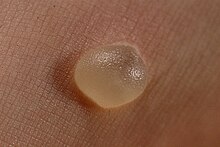Elevation of epidc:rmis containing watery liquid
A blister is a small pocket of body fluid (lymph, serum, plasma, blood, or pus) within the upper layers of the skin, usually caused by forceful rubbing (friction), burning, freezing, chemical exposure or infection. Most blisters are filled with a clear fluid, either serum or plasma. However, blisters can be filled with blood (known as "blood blisters") or with pus (for instance, if they become infected).
| Blister | |
|---|---|
 | |
| Blisters from abrasive rubbing are common on the feet. | |
| Specialty | Dermatology |
| Causes | Heat, cold, electricity, chemicals, friction, radiation |
The word "blister" entered English in the 14th century. It came from the Middle Dutch bluyster and was a modification of the Old French blostre, which meant a leprous nodule—a rise in the skin due to leprosy.
In dermatology today, the words vesicle and bulla refer to blisters of smaller or greater size, respectively.
To heal properly, a blister should not be popped unless medically necessary. If popped, bacteria can enter. The excess skin should not be removed because the skin underneath needs the top layer to heal properly.
